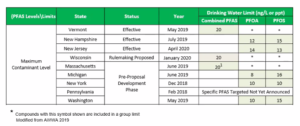Drinking Water Rules Advisory Meeting
Wisconsin’s Department of Natural Resources (DNR) is in early stages of promulgating rules that would regulate PFOA and PFOS in drinking water, surface water, and ground water. The state Department of Health Services (DHS) has recommended a combined groundwater standard of 20 ppt and a preventive action limit of 2 ppt for those two chemicals, but those recommendations are not enforceable until DNR finalizes rules.
A DNR stakeholder group met on July 14 to discuss the drinking water standards. At the meeting, DNR provided an update on Environmental Protection Agency (EPA) and other states’ regulatory actions to address PFAS in drinking water.
EPA is currently gauging whether or not to set a national maximum contaminant level for PFOA and PFOS. If the agency makes the determination to regulation, EPA then has a 24 month timeline to publish a proposed rule. Recently, a group of state attorneys general including Wisconsin Attorney General Josh Kaul urged EPA to regulate the chemicals. Currently, EPA has set a nonenforceable public health advisory level of 70 ppt.
Just three other states have final, enforceable drinking water standards for PFOA and PFOS: Vermont, New Hampshire and New Jersey. Six states including Wisconsin are in the process of developing regulatory standards. An additional 11 states have health based guidance levels, many around the EPA number of 70 ppt.
DNR then laid out the timeline for next steps on the drinking water rules. DNR will continue rule drafting and advisory group meetings through 2020, with the goal of producing a draft economic impact analysis by the end of 2020. DNR aims to have the DNR Board approve rule language by January 2021, then move forward on an economic impact analysis in early 2021 and public hearings in August 2021.
WisPAC Meeting
DNR, as directed by the governor in Executive Order #40, is leading a group of Wisconsin state agency officials (Wisconsin PFAS Action Council, or WisPAC) as they prepare to present a state PFAS action plan to the governor and legislature. WisPAC met on July 16 to discuss next steps on preparing a draft action plan.
DNR and WisPAC members spent the first part of the meeting laying out and approving the structure of the action plan, which will include issue papers on mapping, research, financial tools, outreach & communication, PFAS clean sweep, and PFAS containing products. Agencies discussed a few additional items to add to the plan, such as environmental justice and health equity, blood testing and medical services for veteran firefighters, and coordination with other states and the federal Department of Defense.
DNR shared ideas from the public survey WisPAC released earlier this year. Most popular ideas from the public survey were banning PFAS, determining liability and responsibility for cleanup, and setting enforcement standards.
WisPAC will continue to discuss the draft action plan for the next month before it meets again in August to approve a draft plan. Following WisPAC approval, there will be a public comment and listening sessions before WisPAC releases the final plan to the governor and legislature.
